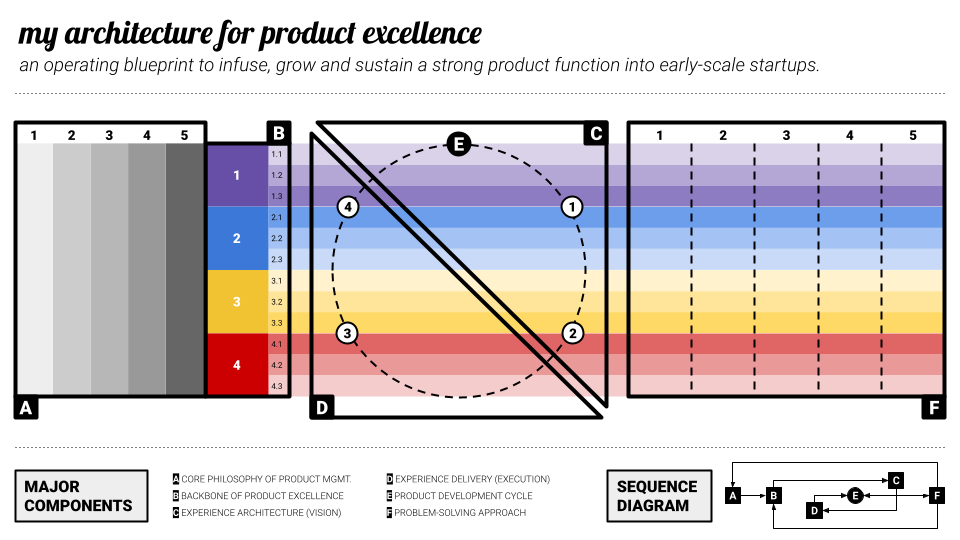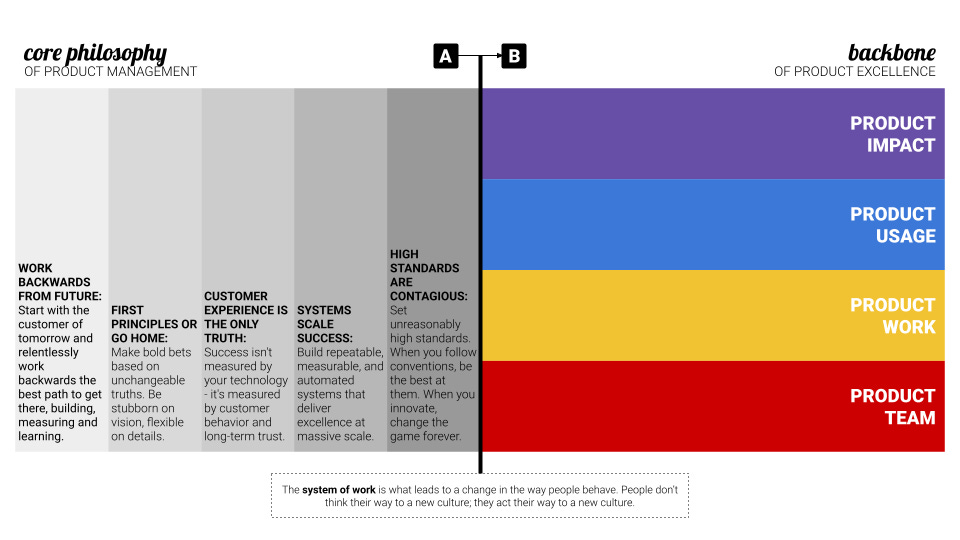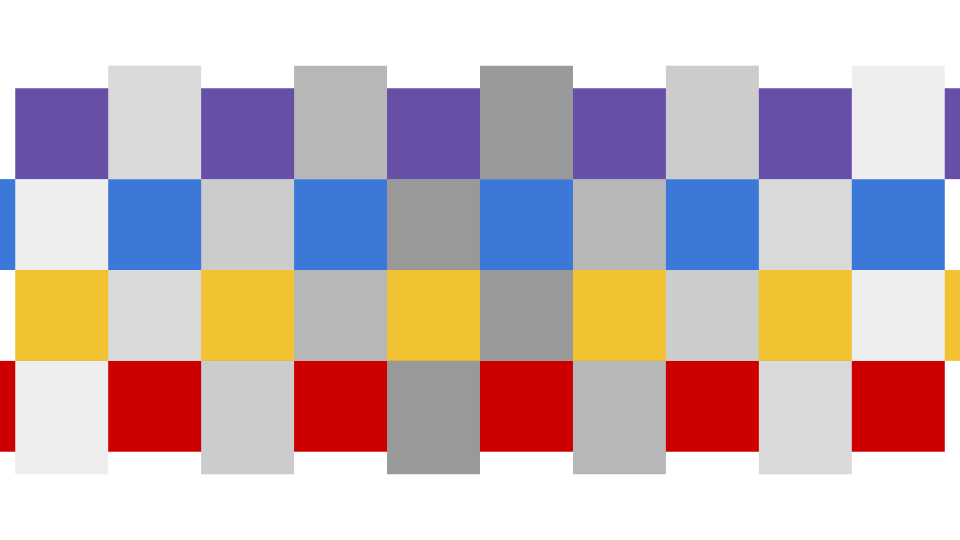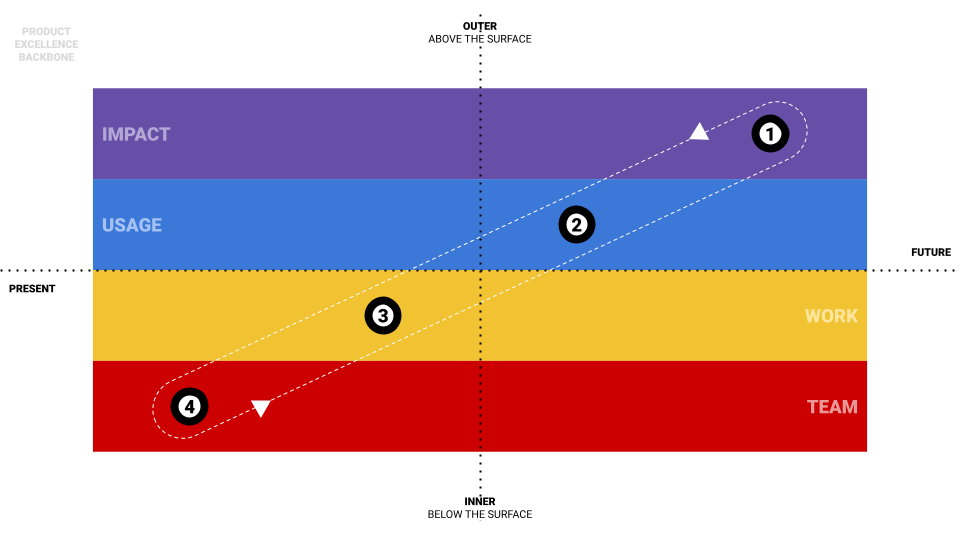Designing the Future With a Strong Product Vision (4/8)
A major component that triangulates ambition, creativity and operational capabilities

Continuing the series that describes each component of my Product Excellence Architecture, it's time to explore component C, the Product Experience Architecture, the system that designs the future of the product and its potential results.
In the two previous posts, I introduced you to two foundational components of the architecture, the core philosophy and the backbone. Imagine that from now on these two components intertwine, forming a kind of vital fabric or a safety net that runs through the entire architecture of excellence, supporting the other strategic, tactical and operational components.
When we superimpose a dimensional vision of future and present, and of the outside world and the inside world, on the layers of the backbone intertwined with our philosophy, two strategic systems emerge with the responsibility of dealing with the natural tensions between Product Impact, Product Usage, Product Work and Product Team. One of these systems is represented by component C, which will design the right product to be built, and the other is component D, which will deal with building the product the right way. The right product, and the product right.
From the perspective of the logical model on which my backbone concept is inspired, the Experience Architecture signals the intended results by stitching together all the elements of the Product Impact and Product Usage layers without losing sight of the operational capacity for developing the product in question.
But let me be clear… Component C isn’t about what to build next. It’s about designing a future worth building toward. Think of it as your product’s North Star, but with teeth—a system that:
Triangulates ambition, creativity, and reality (more on this below)
Creates shared consciousness (not just alignment)
Turns “science fiction” into executable strategy
Although this post is about component C, it is worth mentioning some fundamental and complementary differences with component D. (the table below inspired by a distinction that Shreyas Doshi proposes between Product Thinking and Project Thinking)
It's crucial to understand the distinction between designing the future experience (component C) and building the vision (component D). Component C focuses on defining, projecting, designing, and prototyping the future experience while estimating its impact. It's where we envision the product and its intended results – it's conceptual but testable through simulations and prototypes.
This "design" phase (C) relies heavily (80%) on understanding the Impact and Usage aspects of the Backbone of Product Excellence. It's about deeply understanding how the product will affect users and how they will interact with it. The remaining 20% draws on the Work and Team aspects, considering what's realistically achievable given current capabilities.
Component D transforms this vision into reality – it's where the story becomes action. This phase will rely heavily (80%) on the Work and Team aspects of the Backbone, focusing on the processes, collaboration, and execution required to bring the vision to life. Only 20% will be based on Impact and Usage, as these aspects have been thoroughly considered in the "design" phase.
Together, these strategic systems form the foundation for tactical operations in your product development cycle (E). They create a framework where day-to-day decisions naturally align with your long-term vision while remaining grounded in current capabilities.
[Further details about Component D will be explored in a future post.]
Experience Architecture (C) and Vision Building (D) aren't just high-level frameworks—they're strategic systems that directly enable tactical operations in your product development cycle. While component C helps you design the future experience through vision and prototypes, component D transforms this vision into an operational plan for the present. Together, they create a continuous feedback loop that guides your tactical decisions in the product development cycle (E).
Think of these components as the bridge between strategic thinking and operational execution. Every work planning session, every feature prioritization decision, every technical architecture choice should be informed by the narrative and direction set in your Experience Architecture. This strategic-tactical alignment ensures that your day-to-day operations consistently move you toward your envisioned future.
The Experience Architecture, a story About the Future.
Jeff Patton argues that product vision is "science fiction" – not in a negative way, but to emphasize that it’s a story we tell about how people will use our products in the future. It’s about creating a shared consciousness of that future, a common purpose, not just writing a document that sits on a shelf.
Experience Architecture, in this context, is about crafting that compelling story. It’s a system for defining clear outcomes and working from the outside in—starting with the user experience and then working backward to the technology development and operational capabilities. It’s about envisioning the ideal future state for your customers and then telling the story of how that future will become a reality.
Often, people confuse “vision” with “strategy” or “tactics.” While all three are essential, they serve different purposes. Your vision is the story—the narrative that inspires and aligns. Your strategy is the plot—the high-level plan to bring the story to life. And your tactics are the scenes—the specific actions you take to execute the plot.
The key to a powerful Experience Architecture is focusing on the user experience and turning it into a compelling story. Instead of starting with what’s technically feasible, you begin with what’s desirable for your customers and build a narrative around it. What problems are you solving for them? What value are you creating? What kind of experience do you want them to have, and how does that impact their lives?
Designing the Future by Triangulating Ambition, Creativity and Operational Capabilities
The Experience Architecture (component C) is about designing the future by triangulating three key elements: ambition, creativity, and operational capabilities. There is a delicate balance between our desired impact, innovation & disruption level, and what we can actually deliver at this time. It's about "planting the flag" for the future you want to create, using the narrative as a guide.
Ambition (Impact): This is the "why" behind your product. What impact do you want to make on the world? What problems are you aiming to solve? What is your BHAG? This connects directly to the Impact aspects of the Backbone of Product Excellence.
Creativity (Experience): This is the "how" – the way you'll generate that impact through a unique and compelling user experience. It's about crafting a narrative that resonates with your users and solves their problems in an innovative way. This links to the Usage aspects of the Backbone.
Operational Capabilities (Feasibility): This is about understanding what's realistically achievable given your startup's current resources and capabilities. While ambition and creativity drive the vision, operational capabilities ground it in reality. This relates to the Work and Team aspects of the Backbone.
As a system that architects the experience as a whole and creates a shared understanding about your product story, component C triangulates these elements having the Backbone and the Core Philosophy of Product Management as its safety net.
In this stage, the compelling story gains life through prototypes. These prototypes, whether low or high fidelity, aim to allow the team visualize the future experience and validate if it is on the right track. This is an iterative process of constant learning and refinement.
Component C isn’t about predicting the future—it’s about designing a future you’re willing to bet your work on. And in a world drowning in features but starved for meaning, that’s the only edge that lasts.
Here's a framework that I've found effective:
Set Your Future Time Horizon: Anchor your story in a specific point in the future. This gives it a sense of direction and helps you focus on the long-term impact.
Describe the Future (Without Thinking of Your Product Specifically): Start by painting a picture of the future world where your product could exist. What are the key trends? What are the challenges and opportunities?
Think About Your Users in the Future: How are your users living in this future world? What are their needs and desires? How is their life different because of the changes happening around them?
Tell Your Future Product Story: Now, introduce your product into the story. How does it fit into this future world? How does it help your users overcome challenges and achieve their goals? What role does it play in their lives?
Communicate Your Story: Share your story with your team, your users, and your stakeholders. Get feedback and refine it over time. The story should be a living document that evolves as your startup grows.
Integration with Operations: Your Experience Architecture shouldn't exist in isolation. Create clear connections between your vision story and your operational frameworks. How does it influence your OKRs? Your technical architecture decisions? Your hiring plans?
Regular System Review: Treat your Experience Architecture as a living system, not a static document. Schedule regular reviews to ensure it evolves with your understanding of the market and your capabilities. This isn't about changing your vision frequently, but about ensuring your story remains compelling and relevant as your context evolves.
Why is Experience Architecture (the Story) So Important?
A well-defined Experience Architecture isn't just a nice-to-have; it's a critical success factor for early-scale startups. Here's why:
Shared Consciousness: The primary purpose of a vision is to create a shared understanding within the team. A compelling story creates a mental picture that everyone can relate to and act upon, far more effective than any dry document.
Inspiration and Alignment: A good story inspires and aligns people. It motivates them to work towards a common goal and gives them a sense of purpose. In a startup environment where resources are limited and every decision counts, this alignment is crucial for survival and growth.
Guiding Decisions: When faced with tough choices, the vision story acts as a filter. Does this decision move us closer to the future we've envisioned? Does it fit the narrative we're building? This filtering mechanism becomes increasingly valuable as your team grows and decisions become more distributed.
Communication: A clear vision story is easier to communicate to stakeholders, investors, and potential hires. It's a more engaging and memorable way to convey your company's purpose and potential, crucial for securing resources and attracting talent.
Keep in mind that a system requires shared consciousness before it can reap the benefits of empowered execution.
What You Might Be Missing Without a Strong Vision System
When product teams operate without a well-defined Experience Architecture, the consequences often cascade throughout the organization in subtle but critical ways:
Decision Paralysis: Without a clear vision story, teams struggle to evaluate opportunities and threats effectively. What seems like careful deliberation often masks a fundamental inability to make strategic choices. You might find yourself constantly revisiting decisions or unable to build momentum around key initiatives.
Strategic-Tactical Disconnect: Teams may execute flawlessly on a tactical level while moving in strategically questionable directions. You might be building features perfectly but missing the bigger picture of how they contribute to your desired future state.
Stakeholder Misalignment: Different parts of your organization develop their own interpretations of where the product is heading. This creates friction with investors who can't clearly see your long-term value proposition, and with team members who struggle to connect their daily work to a larger purpose.
Investment Inefficiency: Without a clear vision system, resources get scattered across initiatives that don't compound. You might be making progress on multiple fronts without meaningfully advancing toward any specific future state.
What you're really missing isn't just a document or a presentation—it's a shared consciousness about the future you're building toward. This shared understanding is what enables truly empowered execution, where teams can make rapid, aligned decisions without constant oversight.
In the next post, we’ll explore Component D: Building the Product Right, and put some concepts in the perspective of the two strategic components (C + D) of the Architecture of Product Excellence. Concepts like:
Vision Velocity
Introduce concept of "vision velocity" - how quickly a team can move toward its envisioned future
Discuss factors that increase or decrease this velocity
Provide ways for measuring vision velocity
Experience Debt
Similar to technical debt, but for user experience
How short-term decisions can accumulate to create friction with long-term vision
Strategies for managing experience debt while maintaining progress
Vision-Operation Fit
Framework for assessing whether operational capabilities match vision ambition
Tools for identifying and addressing gaps
Strategies for growing capabilities to match vision
So stay tuned to continue this journey into Product Management realm.








